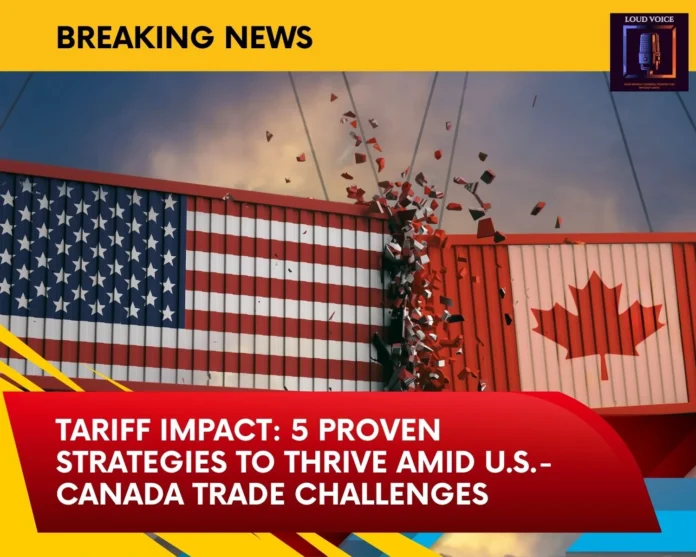Tariff Impact: Introduction
As of April 2, 2025, U.S. tariffs imposed in February 2025, including a 25% tariff on Canadian goods, have created uncertainty for Canadian businesses. Canada retaliated with tariffs on $30 billion in U.S. goods from March 4, 2025, and another $29.8 billion from March 13, 2025, affecting industries like agriculture and manufacturing. This has raised prices and squeezed profit margins, potentially reducing demand.
Case Study: PCB Global’s Experience
PCB Global Trade Management, a B.C.-based logistics firm, reported a 500% increase in calls as businesses sought clarity on tariff impacts. They’ve hired more staff and extended hours, advising firms on alternate trade partners like European agreements, showing how logistics firms are helping navigate this challenge.
Adaptation Strategies
Businesses can diversify supply chains using agreements like CETA and CPTPP, optimize operations with tariff assessments, and access government loans, such as $500 million from the Business Development Bank of Canada. These strategies aim to reduce costs and build resilience, though implementation requires investment.
Detailed Analysis and Insights
In the current economic climate, particularly as of 08:09 AM PDT on Wednesday, April 2, 2025, the tariff landscape between Canada and the United States has introduced significant challenges for Canadian businesses, prompting a detailed examination of the situation, impacts, and adaptive strategies. This section provides a comprehensive overview, expanding on the key points and incorporating additional insights to ensure a thorough understanding, based on recent research and industry observations.
Background and Tariff Developments
The escalation of tariffs began with U.S. President Donald Trump’s executive orders in February 2025, imposing a 25% tariff on Canadian goods, with a 10% tariff on energy imports, effective from February 1, 2025, as part of addressing national security concerns related to illegal immigration and drug trafficking. Canada responded swiftly, announcing a 25% tariff on $30 billion in U.S. goods effective March 4, 2025, followed by an additional $29.8 billion effective March 13, 2025, targeting products like steel, aluminum, tools, and consumer goods. These measures were part of a broader strategy to protect Canadian interests, with potential expansion to $155 billion if U.S. tariffs persist.
The timing, as of April 2, 2025, shows these tariffs are still in effect, with no new announcements found for today’s “Liberation Day” mentioned in the original text, suggesting it may have been a misnomer or not officially recognized. The Canada-U.S. trade relationship, valued at $2.5 billion daily, is under strain, with significant implications for both economies, as noted in recent government reports.
Economic and Operational Impacts
The tariff impact on Canadian businesses is multifaceted, affecting costs, supply chains, and employment. The Bank of Canada’s January 2025 Monetary Policy Report highlights that tariffs could disrupt supply chains, reduce business investment by nearly 12% by early 2026, and lower economic growth to below 1.8% in 2025 and 2026, with higher import costs for machinery and equipment, which Canadian businesses buy roughly half from the U.S. This is particularly challenging as businesses face squeezed profit margins, with higher costs passed on to consumers gradually, potentially reducing demand.
Industry insights from KPMG Canada note that the uncertainty has led companies to rush for mitigation strategies, including optimizing operations, forming partnerships, and diversifying supply chains. PwC Canada emphasizes the need for data-driven decisions, with businesses assessing tariff impacts to align financial and trade strategies, reducing risks and avoiding unexpected costs. For employees, the potential for layoffs, hiring freezes, and reduced hours could lead to financial stress and mental health issues, impacting local economies with rising unemployment and decreased consumer spending, as discussed in recent business analyses.
Case Study: PCB Global Trade Management

PCB Global Trade Management, part of Pacific Customs Brokers, has been a critical player in this scenario, with their website detailing services in customs brokerage and freight management, aligning with the reported 500% surge in calls. They’ve hired additional staff and extended hours, working weekends and overnights, to meet demand, advising companies on alternate trading partners like European free trade agreements and the Trans-Pacific Partnership. This case study illustrates the operational strain and adaptive measures, with PCB Global helping firms navigate compliance and explore new markets, emphasizing their role in mitigating the tariff impact. Their services, including trade advisory and tariff optimization, are tailored to meet the needs of importers facing increased complexity, as seen in their recent updates.
Adaptation and Resilience Strategies
To navigate the tariff impact, Canadian businesses can adopt several strategies, supported by government and industry insights. Diversifying supply chains is key, leveraging agreements like the Canada-European Union Comprehensive Economic and Trade Agreement (CETA) and the Comprehensive and Progressive Agreement for Trans-Pacific Partnership (CPTPP), as noted by PCB Global’s insights on global export markets. Optimizing operations involves using tariff impact assessments and modeling to identify cost-saving measures and streamline processes, as recommended by recent industry reports.
Government support is also crucial, with measures like $500 million in favorably priced loans through the Business Development Bank of Canada and $1 billion in new financing through Farm Credit Canada for agriculture, aimed at addressing cash flow challenges and supporting impacted sectors. Additionally, deferring corporate income tax payments and GST/HST remittances from April 2 to June 30, 2025, provides up to $40 billion in liquidity, offering relief to businesses, as outlined in government announcements. Seeking trade advisory from experts like PCB Global can mitigate penalties and simplify declarations, while exploring new markets, given international trade represents over 60% of Canada’s GDP, offers growth opportunities, as highlighted in trade-focused publications.
Long-Term Outlook and Conclusion
Looking ahead, the tariff impact on Canadian businesses may prompt a shift toward global trade diversification, with a focus on agreements like CETA and CPTPP to reduce reliance on the U.S. market. This long-term vision requires collaboration between businesses, government, and logistics firms, with ongoing monitoring of tariff developments and economic indicators. While challenges persist, the adaptive strategies outlined provide a roadmap for resilience, transforming the tariff impact into an opportunity for innovation and growth, as suggested by recent economic forecasts.
Table: Key Tariff Measures and Impacts (As of April 2, 2025)
| Date | Measure | Impact on Canadian Businesses |
| February 1, 2025 | U.S. imposes 25% tariff on Canadian goods | Increased export costs, disrupted supply chains |
| March 4, 2025 | Canada imposes 25% tariff on $30B U.S. goods | Higher import costs, potential retaliation |
| March 13, 2025 | Canada imposes 25% tariff on $29.8B U.S. goods | Further cost increases, pressure on profit margins |
| April 2, 2025 | No new announcements found for “Liberation Day” | Continued uncertainty, reliance on existing measures |
This table summarizes the timeline and effects, providing a clear overview for stakeholders, and reflects the current state as of April 2, 2025, based on available data.


